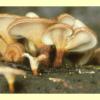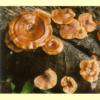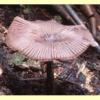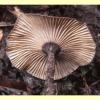





The pileus of Pleurotus can be infundibuliform (as is typical for Panus), but it is often rounded or plane, and never coarsely hairy. Pleurotus tuber-regium usually has a sclerotium. Pleurotus giganteus has a very large fruit-body with a rooting stipe base and spores that are ellipsoid.
Cole, F.M., Fuhrer, B.A. & Holland, A.A. (1984), A Field Guide to the Common Genera of Gilled Fungi in Australia, revised edn. Inkata Press, Melbourne. [Illustration of P. fasciatus]
Corner, E.J.H. (1981), The agaric genera Lentinus, Panus and Pleurotus with particular reference to Malaysian species, Beih. Nova Hedwigia 69: 1–169. [Description, B&W Illustration and Microcharacters of P. similis (as P. fulvus var. similis) and Description and Microcharacters of P. lecomtei, and Key to Malaysian species, including three species also found in Australia]
Fuhrer, B. (2005), A Field Guide to Australian Fungi. Bloomings Books, Hawthorn. [Description and Illustration of P. fasciatus and an unnamed species]
Grey, P. & Grey, E. (2005), Fungi Down Under. Fungimap, South Yarra. [Description, Illustration and Map for P. fasciatus]
Grgurinovic, C.A. (1997a), Larger Fungi of South Australia. The Botanic Gardens of Adelaide and State Herbarium and The Flora and Fauna of South Australia Handbooks Committee, Adelaide. [Description and Microcharacters of P. lecomtei (as L. strigosus) and P. fasciatus (as Lentinus) with Key to these two species]
Grgurinovic, C.A. & Mallett, K. (eds) (1996), Fungi of Australia, Volume 1A. Australian Biological Resources Study, Canberra. [Illustration of P. fasciatus]
Hood, I.A. (2003), An Introduction to Fungi on Wood in Queensland. University of New England, School of Environmental Sciences and Natural Resources Management, Armidale. [Description and B&W Illustration of P. fasciatus and P. lecomtei]
McCann, I.R. (2003), Australian Fungi Illustrated. Macdown Productions, Vermont. [Illustration of P. fasciatus]
Pegler, D.N. (1983b), The genus Lentinus: a world monograph, Kew Bull., Addit. Ser. 10: 1–281. [Description, B&W Illustration and Microcharacters of the six Australian species mentioned above, all as Lentinus, and Key to world species, under Lentinus subgenus Panus, although note that most species of sections Pulverulenti, Squamosi and Cirrhosi belong in Neolentinus, and Panus tuber-regium is a Pleurotus]
Pegler, D.N. (1983c), Agaric flora of the Lesser Antilles, Kew Bull., Addit. Ser. 9: 1–668. [Description, Illustration, B&W Illustration and Microcharacters of Panus lecomtei (as Lentinus strigosus)]
Pegler, D.N. (1986), Agaric flora of Sri Lanka, Kew Bull., Addit. Ser. 12: 1–519. [Description, B&W Illustration and Microcharacters of P. ciliatus (as Lentinus), P. lecomtei (as Lentinus strigosus) and P. similis]
Pegler, D.N. (1997), The Larger Fungi of Borneo. Natural History Publications, Kota Kinabalu. [Illustration of P. ciliatus (as Lentinus) from Borneo]
Young, A.M. (2005b), A Field Guide to the Fungi of Australia. University of New South Wales Press, Sydney. [Description and Illustration of P. fasciatus]
